2020 Census: Information Graphics to Overcome Participation Barriers
- Public Policy

ArtCenter graphic and product design students were challenged to consider how the upcoming 2020 U.S. Census, which determines how collective money and political power in the United States will be distributed over the next decade, can effectively reach populations that are typically undercounted: children ages 0-4, immigrants, Latinx and black communities, and people with unstable living situations. Since census undercounting leads to a less equitable distribution of resources, students examined the barriers to participation and the role of storytelling in data collection as they investigated effective ways to connect communities so everyone can be counted in 2020.
Project brief
Using data associated with the Census 2020, ArtCenter students created multidisciplinary projects to promote participation in the upcoming census, targeting populations that are typically undercounted.
Students designed visually compelling projects – involving print, interaction, packaging, product design, temporal mediatecture and motion graphics – that would communicate the importance of responding to the Census which determines how collective money and political power will be distributed for the next decade.
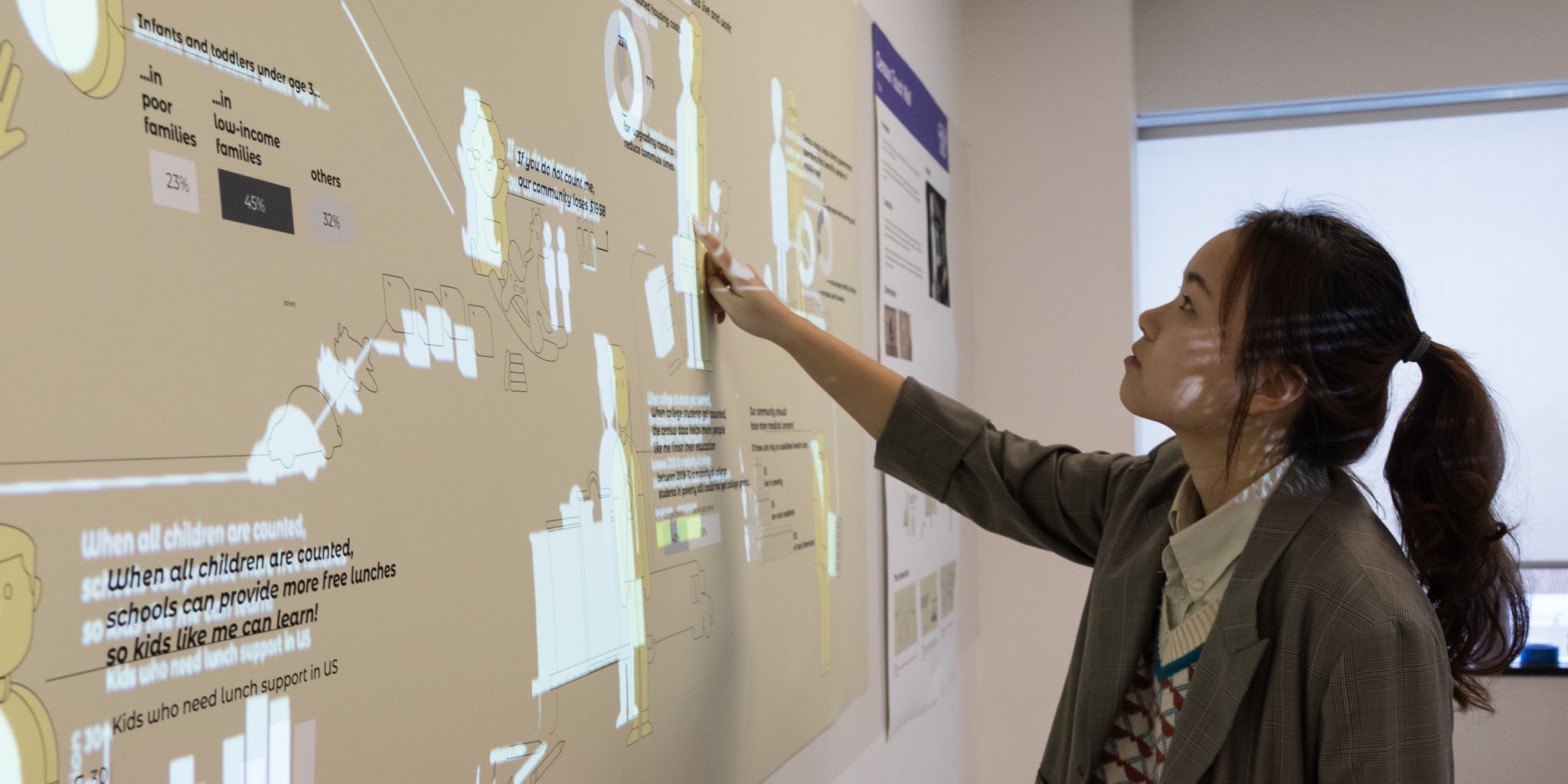
“Sometimes in government, we have blinders on because we do things a certain way all the time. Seeing what you all have created has really opened my eyes to new colors, different messaging to what is possible.”
– Kimberly Briggs, Project Coordinator, Communications, Mayor Eric Garcetti Census 2020 Initiative
About the U.S. Census 2020
Every 10 years the U.S. Census counts every person living the 50 states, District of Columbia and the five U.S. territories. This short survey determines how the collective money and political power will be distributed for the upcoming decade.
The next U.S Census begins April 1, 2020, and will be the first census to offer options to respond online or by phone in addition to the traditional paper response.
The census provides critical data that lawmakers, business owners, teachers, and many others use to provide daily services, products, and community support. Every year, billions of dollars in federal funding go to hospitals, fire departments, schools, roads, and other local resources based on census data.
The results of the census also determine the number of seats each state will have in the U.S. House of Representatives, and they are used to draw congressional and state legislative districts.
The count is mandated by the Constitution and conducted by the U.S. Census Bureau, a nonpartisan government agency. The 2020 Census marks the 24th time that the country has counted its population since 1790.

“During our research, data could be overwhelming. Each year there was data, and it was all on this Excel spread sheet. When we were looking at the data it started to look like, well, texture. That’s where our idea came into play. But we still had to make that data understandable and relatable.”
– Nancy Tsai, Student, Product Design + Designmatters Minor
Research and Project Development
For the first part of the studio, students immersed themselves into the basics of informational graphics, learning how to visually communicate complex data and concepts using compelling and engaging designs.
Students then turned their attention to a real-world challenge – Census2020 participation – seeking to put their design-thinking into a practical application.
Two in-class presentations introduced students to the abundance of census data as well as reasons why certain populations don’t typically respond to the census.
Students heard from Maria de la Luz Garcia, the Director of the Census2020 Initiative in the Mayor’s Office of Budget & Innovation, City of L.A., who discussed the impact of the Census locally, L.A.’s strategy for the 2020 Census, and how they are using data to identify and reach traditionally hard to count populations.
Another presentation from Mara Abrams, Founder and Co-Director of Census Open Innovation Labs for the U.S. Census Bureau, provided an overview of the census from a federal level. She noted the open source data available and explained some of the unique, creative and community-based strategies that her lab is using to ensure everyone is counted.
With their target audience in mind, students expanded their census data research as it related to their projects. They correlated smaller slices of data from multiple sources; as they honed their research skills, they began to visualize a complex view of how to design positive effective solutions.
Site visits provided students with additional tangible information about design opportunities to reach these often undercounted populations. Children’s hospitals were particularly interesting as these institutions welcome a tremendous number of young children and babies (who are typically undercounted) and their parents (who are often part of groups that do not respond to census).
Students ideated on translating data into effective solutions that could embrace many different outcomes from printed materials, digital interaction, advertising campaigns, motions graphics and more. They delved into their medium, exploring, testing and designing solutions that, while graphically pleasing, would also effectively reach their audiences and compel them to action.
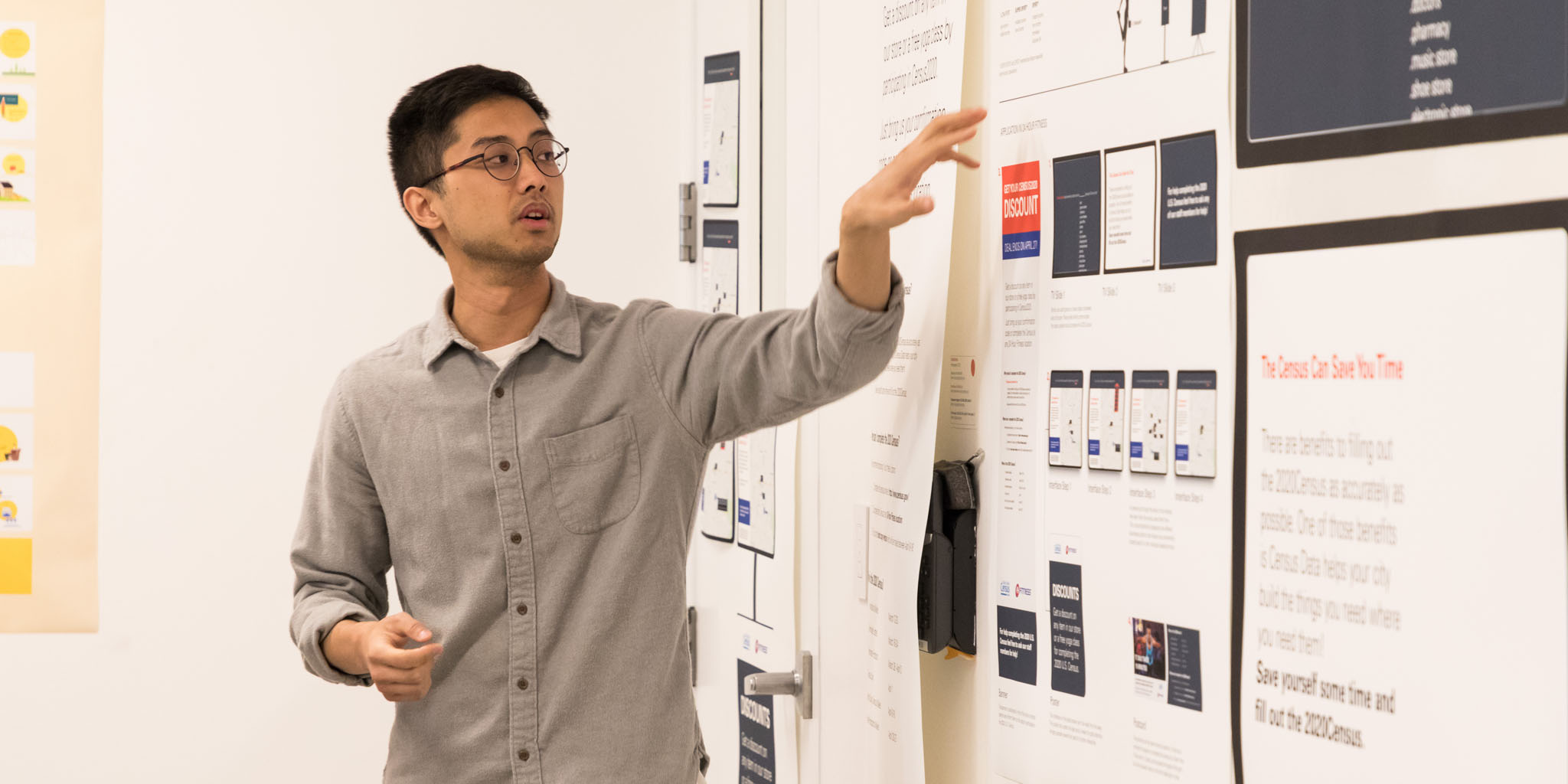
“The thing that impresses me the most about these students is that they are always learning something new. I was really impressed by their willingness to embrace something that was completely strange to them, bring their assets to it, the ones they already possess, an also to do the hard work and ramping it up quickly to present these concepts.”
– Allison Goodman, Faculty, Graphic Design
Project Outcomes
 close
close
DATUM
Read moreCatherine Buan, Anna Kang, Nancy Tsai
DATUM offers census awareness, identification and active participation through fashion. This multi-prong system features data-generated textiles, digital and pop-up experiences and personalized census-related products.
Targeting Millennials and GenZs, DATUM products feature a specific number which corresponds to a state data funding point. On a website, shoppers find a cause that they want to support and discover the specific data point related to that cause – which can adorn a t-shirt, canvas bag and/or scarf. The same products will be promoted via social media/social influencers and ads that, in addition to selling the brand, relay information about the importance of the census and how it affects all residents’ daily lives.
On the first day of the census count, pop-up stores will feature the products and special offers as well as an information wall describing how the census is in a specific community. In a semi-private area, shoppers can complete their own census and receive product discounts.
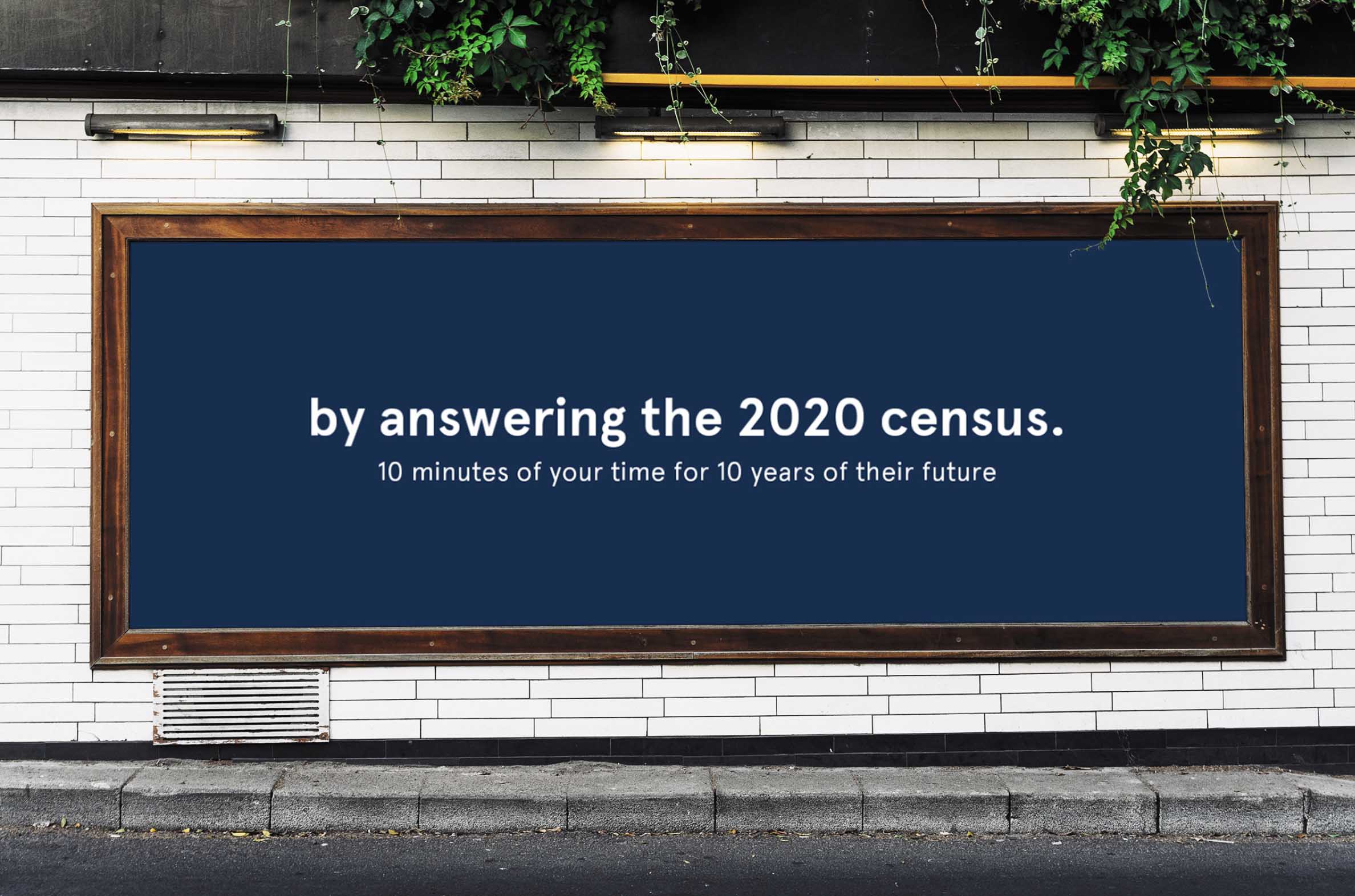 close
close
Engagement and Altruism
Read moreShine Chang
Installed in a busy urban location (such as Union Station), this interactive kinetic poster functions as a public art piece that creates tangible incentives for the hard-to-count transient populations.
Using live video capture technology and triggered by sensors, images of walkers are incorporated into the giant screen. This project employs a two-part solution to encourage census participation and offers altruist incentives for this elusive target audience.
The system’s “passive” state captures walkers’ silhouettes and mirrors them on the projected surface with the message: “Anyone can help everyone through taking the census.” When a curious walker approaches the sign, new messaging is triggered to appear; now the display features more complex, data-driven information about Medicaid, Federal Student Loans and Supplemental Nutrition Program. The design connects the viewer with humanitarian reasons to participate; it’s not just “I count,” but “we count” and “they count.”
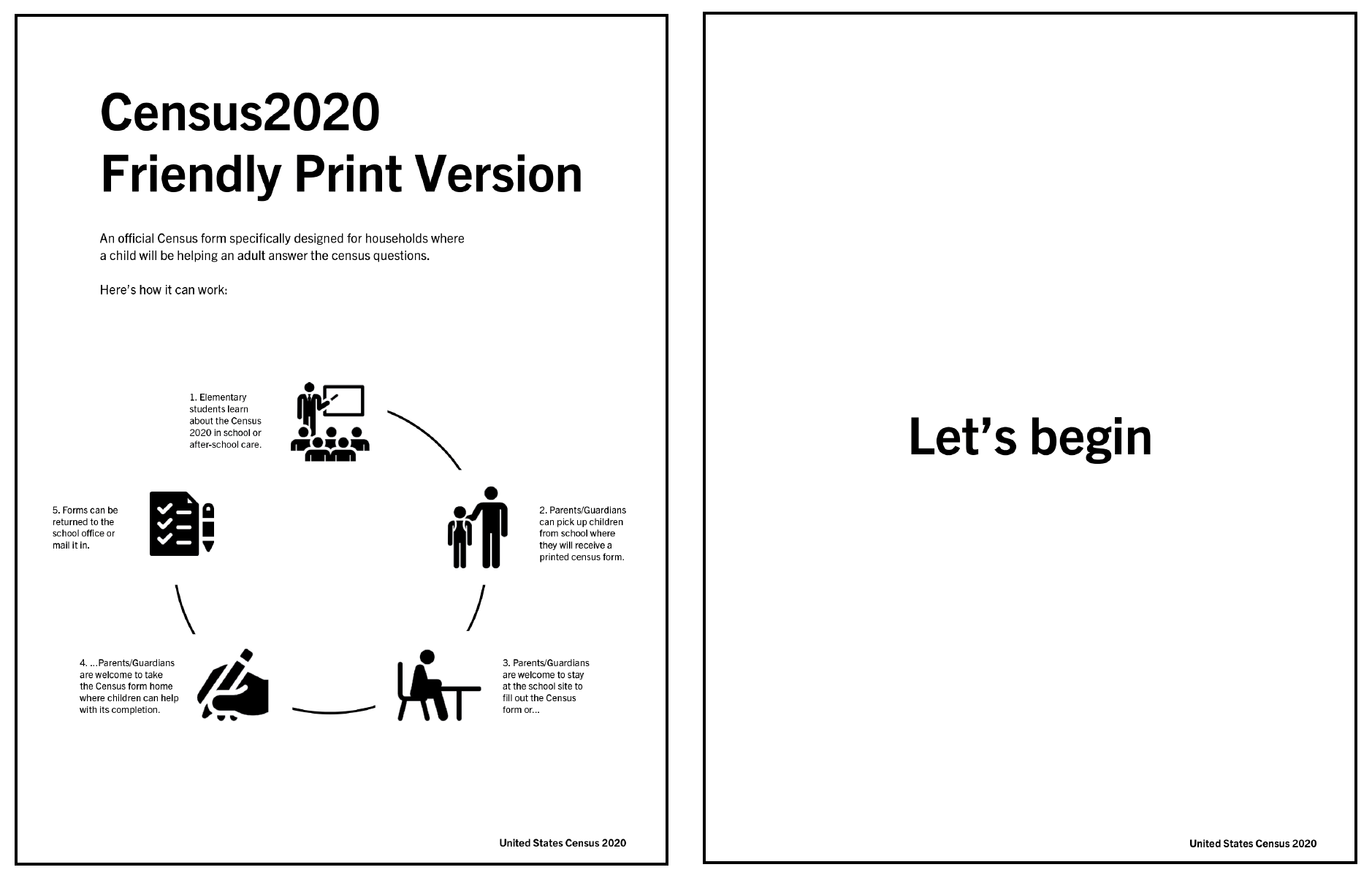 close
close
A Friendlier Census
Read moreAshley Cheou
This redesigned and simplified census form is meant to be filled out by child (with adult supervision) in households where children are more English reading/speaking proficient than adults. This stripped-down, easy-to-read version of the census empowers children to play an active role in their families – and will set the stage for them to respond to the census as they mature.
Through their elementary and secondary schools, children will be educated about the importance of the census when it comes to resources, etc. Additionally, definitions and clarifications are included in the form’s margins to answer frequently asked questions.
 close
close
The Census Game
Read moreErin Hill
A tabletop game with an accompanying monitor explains the benefits of the census and targets parents with young children who are in the waiting area at a children’s hospital.
At the tabletop, children pretend to fill out the census by answering three simple questions about age, others that live in the household and most visited places (schools, libraries, parks, etc.). Children ages 3-5 will need assistance from grownups, while ages 6-11 can play independently.
Deigned in an easy-to-read font, the simple prompts remind players that everyone from babies to great-grandparents needs to be counted – but not pets.
The accompany monitor – hung nearby at adult-level – will reinforce the importance of the census in straight forward text and focuses on the benefits for children’s healthcare.
 close
close
Census Touch Wall
Read moreYu Liu
This large interactive wall at a local children’s hospital will feature infographics that tell the story of how census data affects everyone at all stages of life. Installed at a waiting room area, the touch wall addresses parents and young children; the projected game appeal will first reach children who will also involve their parents in the play/learning.
The wall depicts life stages and touch screens illuminate new projections that describe the role the census plays for that age group. For example, touching the newborn baby will reveal how community services at medical centers are integral for this population. After touching, infographics will remain visible for a short period of time before fading out.
Easy-to-read statistics along with simple drawings of toddlers, children, college students and seniors engage viewers to come closer and interact.
 close
close
Census Playground
Read moreAvital Rachaev
To encourage hard-to-count parents in the San Joaquin Valley, this project employs large-scale graphics installed at Victory Park, a popular playground, to reach parents in this heavily Latinx area who often go under-counted in the census.
Painting surfaces of the playground to encourage active play also reveals census details and takes advantage of the interesting geographical shape of Victory Park. These games incorporate census questions with colorful simple shapes and are positioned around the park.
These semi-permeant installations educate parents through their children as it raises census awareness and importance.
In April, a live event will feature special activities and games with official census assistants on hand to help everyone fill out census forms. The event will also be broadcast in advance via Instagram.
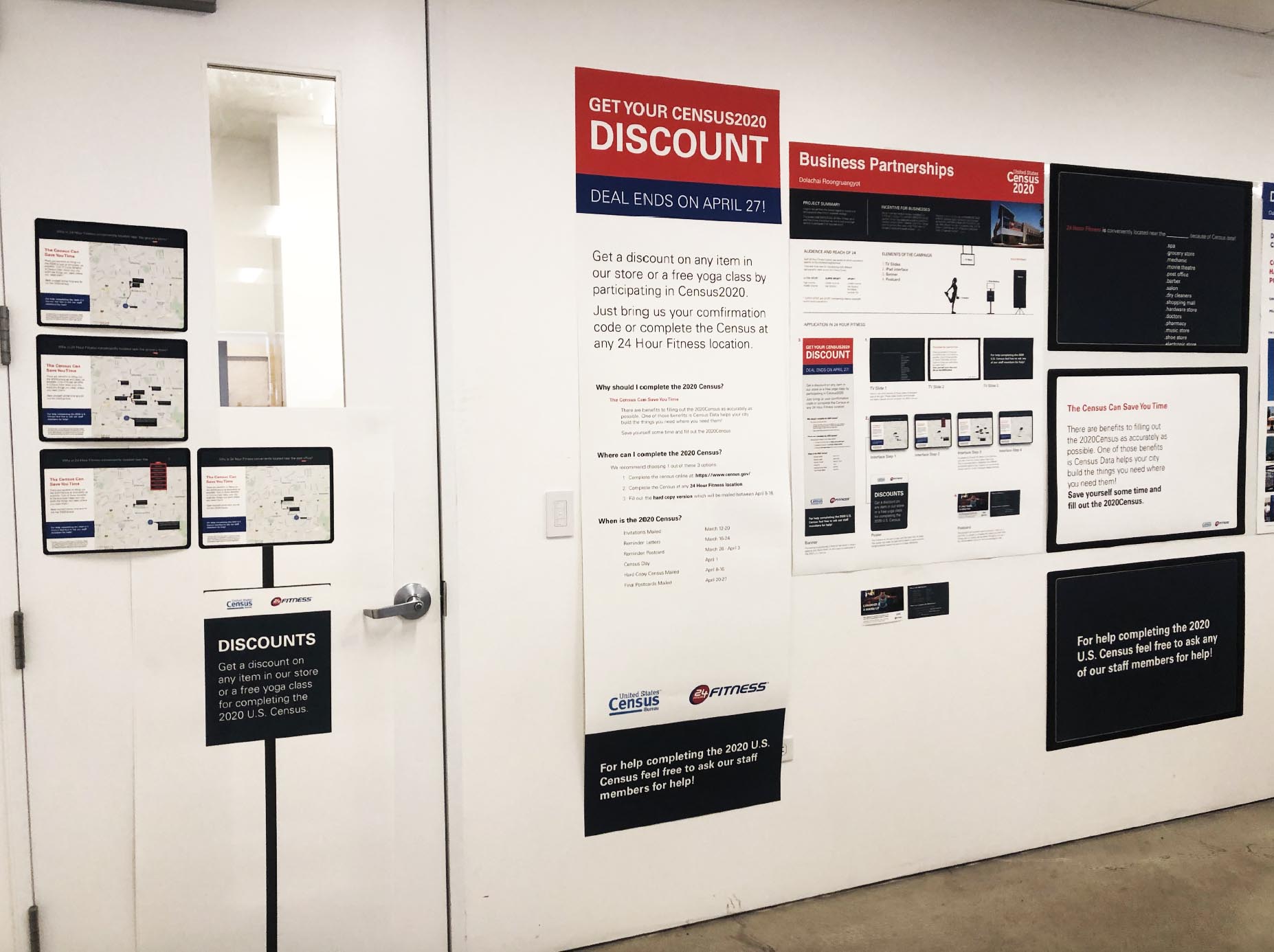 close
close
Business Partnerships
Read moreDolachai Roongruangyot
Businesses know the value of census data; it’s often used to select new locations based on workers, transportation accessibility and other factors. Partnering with the 24 Hour Fitness exercise chain, which reaches a varied ethnic and age demographics, provides mutual benefits for the business and the census.
Since membership levels can include both low to high income individuals, a wide audience will be targeted for the census campaign that includes TV slides, an iPad interface, banners and postcards.
Displayed on monitors as members work out, TV slides will announce the upcoming census, list benefits and encourage participation. Members can scroll through strategically placed iPads near the front check-in desk to learn more about the importance of census participation. Banners and postcards announce Census2020 Discounts available through 24 Hour Fitness, such as product discount or a free class to those who confirm completing the census.
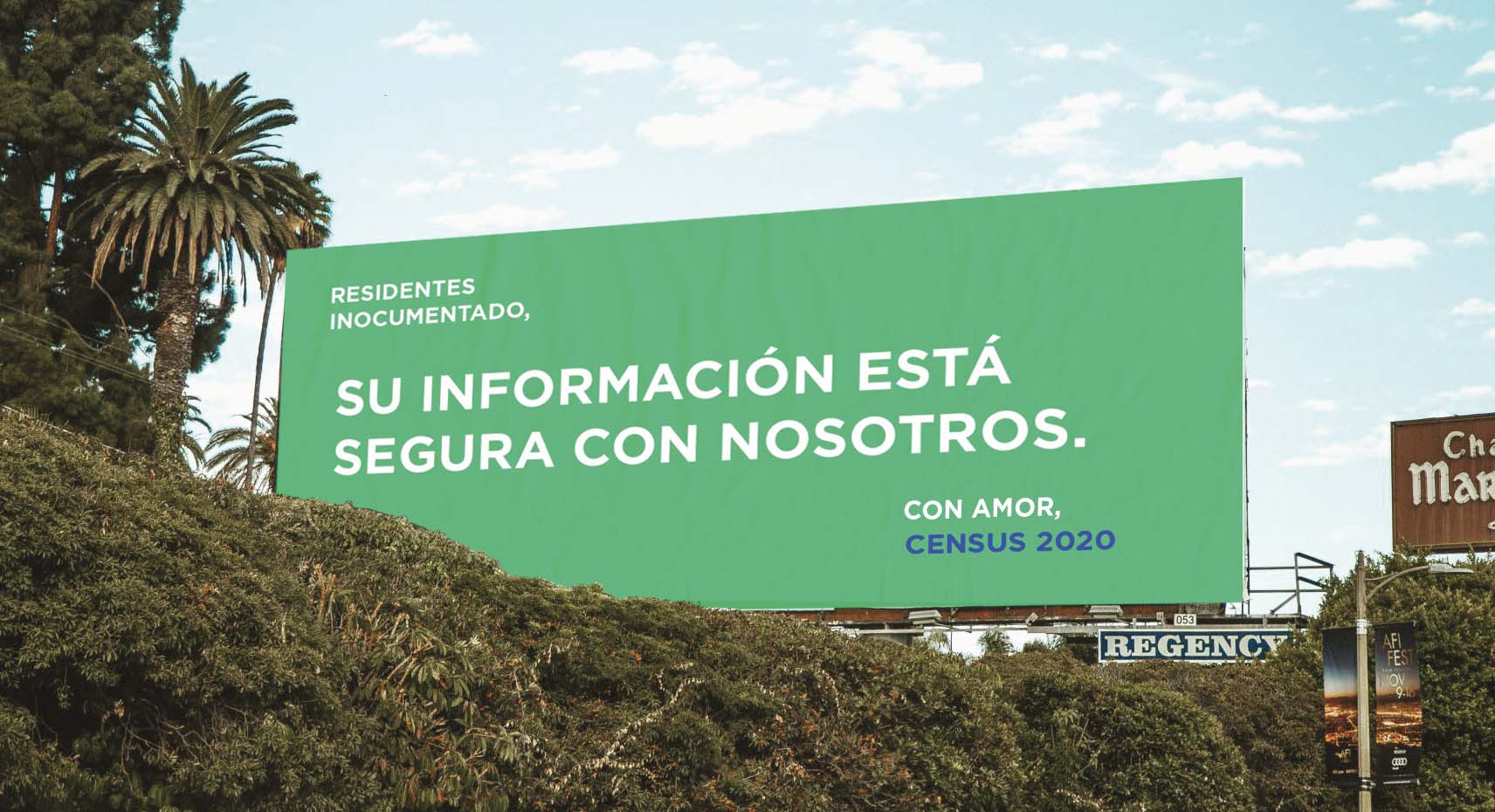 close
close
Dear Resident Campaign
Read moreClaire Selinske
This ad campaign for use in the City of L.A. targets millennials and undocumented residents, groups that are often transient and/or reluctant to participate in the census.
Signage (billboards, bus benches, train stops, buildings, etc.) captures attention with simple short phrases. For millennials (blue background) campaign will incorporate wry humor and a hip personification of Census2020, while for undocumented residents (green background) the signage will stress safety and security of information through bilingual statements.
Physical location and corresponding signage will be important. For example, while in traffic, millennial drivers will read: “Dear Resident: We know you are here or else there wouldn’t be this much traffic. Love, Census2020.” Undocumented signage will be comforting, reassuring and a friendly tone. “Dear Undocumented Resident: We hope to count you. Love, Census2020.”
Signage will also be in heavy rotation on social media in addition to flyers, stickers and other medium.
 close
close
The Census Pie
Read moreChuqing Shao
Targeting college students who are often hard to count, this project explains the multiple benefits of census data such as Federal student loans, social services and affordable housing as it relates to this population.
The project employs a set of three 24 x 36” posters placed in well trafficked corridors of a college campus; graphics address the importance of participation, outlines how money is distributed and reassures information security. These bright colorful, eye-catching graphics combine the familiarity of a pie chart with text directed at college students (Census2020 Funds Your Education), students’ communities (Census2020 Supports Your Family) and those fearful of participation (Census2020 Secures Your Information).
A nearby digital experience also brings the statistical data to life through engaging infographics and the tagline, “Make Sure to Keep Your Piece of the Pie.”
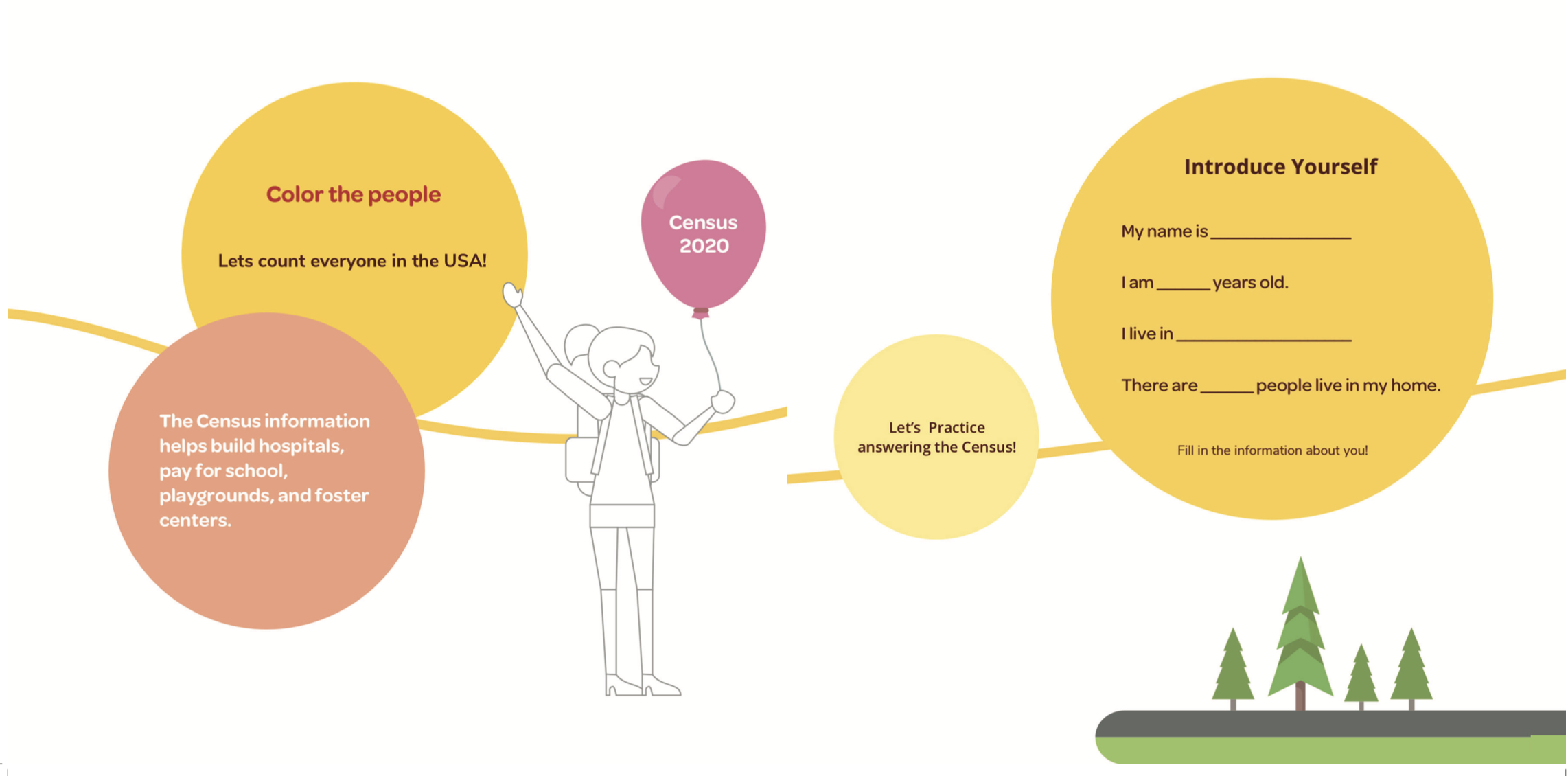 close
close
Colorful Census
Read moreJiexuan Zhao
A paper coloring book engages children as they wait at a local children’s hospital but also helps raise awareness of the upcoming census and positively influence parents toward participation.
Created with appropriate graphics and language, the coloring book describes what a census is and encourages children to “practice” answering the census questions. There is space for coloring, circling selections and writing answers. Children can take the book home with them.
While the children are occupied with their coloring book, parents can watch a video on a screen with similar graphics but with more sophisticated language and descriptions emphasizing the importance of the census and the need to include children of all ages in their forms.
Next Steps
Thanks to the Census Initiative in the Mayor’s Office of Budget and Innovation, student work from the Fall 2020 Information Design studio was exhibited in the 3rd Floor Bridge Gallery at City Hall from March 12 to March 31st, leading up to “Census Day” on April 1st. Photos of the exhibit can be found in the project page gallery.
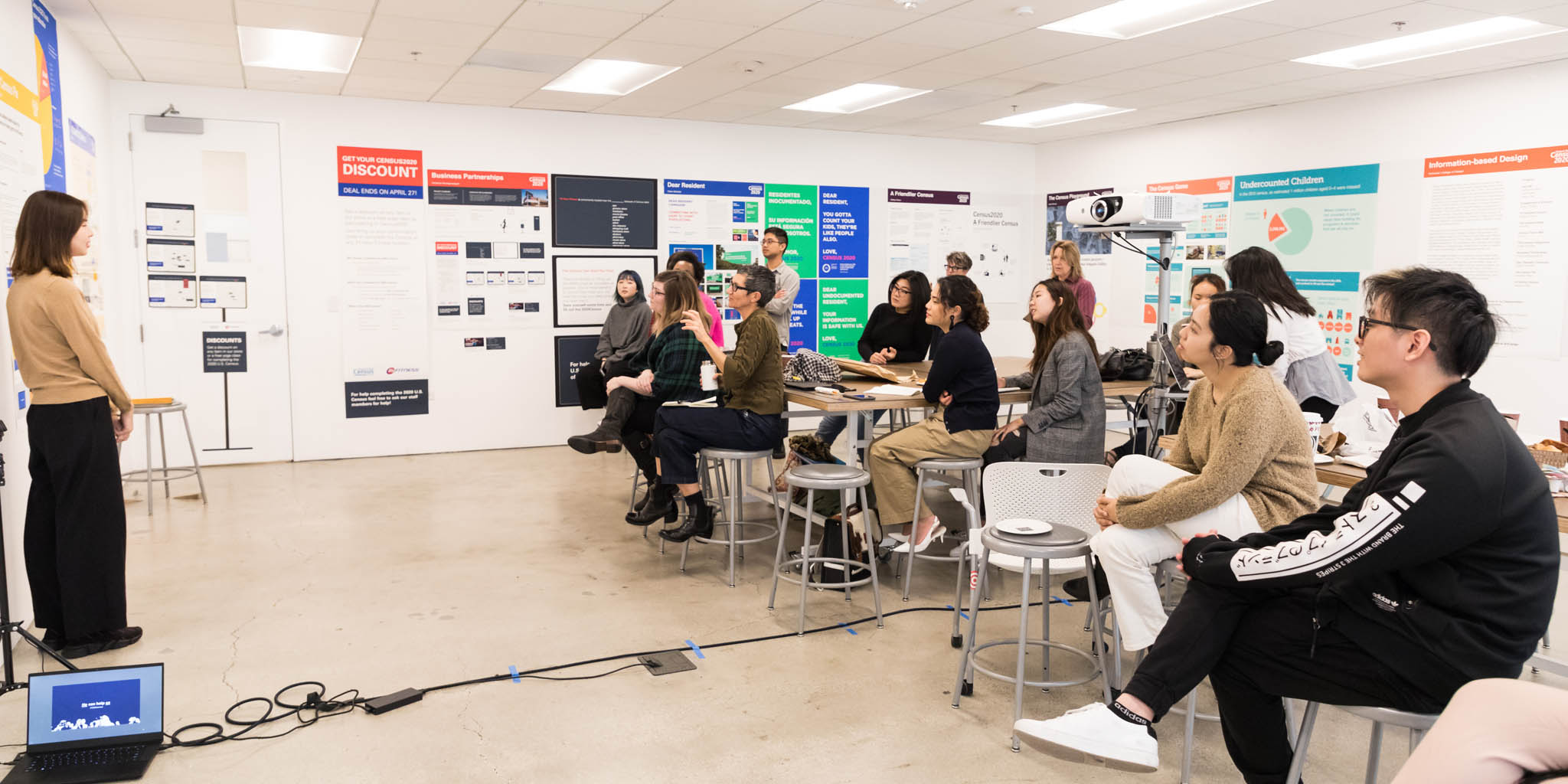
“From the presentations, we learned that one of the biggest undercounted populations is children, particularly young children 0-4 years old. I thought about spaces and locations that parents go with their children, one of them being Children’s Hospital LA. That really encompassed what I was looking for because they admit 400,000 outpatients, 14,000 inpatients, 72,000 emergency visits a year. A lot of people pass through this space which provided lots of opportunities to educate and raise awareness not to mention that people in hospital waiting rooms are often the ones relying on census-based funding programs.”
– Erin Hill, Student, Graphic Design
